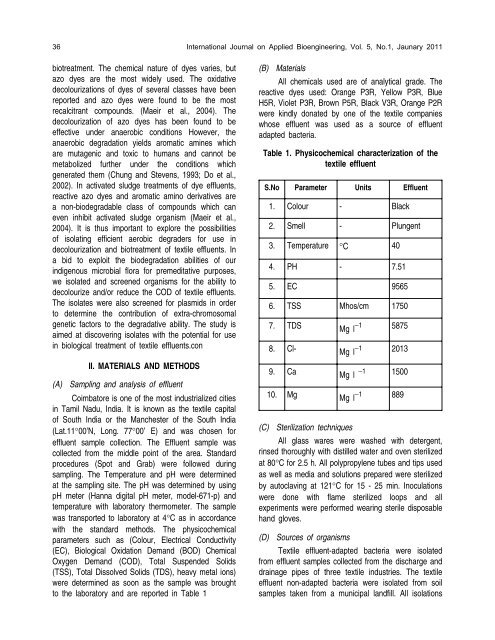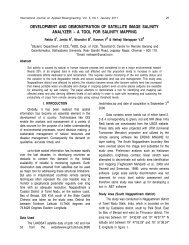decolorization and physico chemical analysis of textile azo dye by ...
decolorization and physico chemical analysis of textile azo dye by ...
decolorization and physico chemical analysis of textile azo dye by ...
Create successful ePaper yourself
Turn your PDF publications into a flip-book with our unique Google optimized e-Paper software.
36 International Journal on Applied Bioengineering, Vol. 5, No.1, Jaunary 2011<br />
biotreatment. The <strong>chemical</strong> nature <strong>of</strong> <strong>dye</strong>s varies, but<br />
<strong>azo</strong> <strong>dye</strong>s are the most widely used. The oxidative<br />
decolourizations <strong>of</strong> <strong>dye</strong>s <strong>of</strong> several classes have been<br />
reported <strong>and</strong> <strong>azo</strong> <strong>dye</strong>s were found to be the most<br />
recalcitrant compounds. (Maeir et al., 2004). The<br />
decolourization <strong>of</strong> <strong>azo</strong> <strong>dye</strong>s has been found to be<br />
effective under anaerobic conditions However, the<br />
anaerobic degradation yields aromatic amines which<br />
are mutagenic <strong>and</strong> toxic to humans <strong>and</strong> cannot be<br />
metabolized further under the conditions which<br />
generated them (Chung <strong>and</strong> Stevens, 1993; Do et al.,<br />
2002). In activated sludge treatments <strong>of</strong> <strong>dye</strong> effluents,<br />
reactive <strong>azo</strong> <strong>dye</strong>s <strong>and</strong> aromatic amino derivatives are<br />
a non-biodegradable class <strong>of</strong> compounds which can<br />
even inhibit activated sludge organism (Maeir et al.,<br />
2004). It is thus important to explore the possibilities<br />
<strong>of</strong> isolating efficient aerobic degraders for use in<br />
decolourization <strong>and</strong> biotreatment <strong>of</strong> <strong>textile</strong> effluents. In<br />
a bid to exploit the biodegradation abilities <strong>of</strong> our<br />
indigenous microbial flora for premeditative purposes,<br />
we isolated <strong>and</strong> screened organisms for the ability to<br />
decolourize <strong>and</strong>/or reduce the COD <strong>of</strong> <strong>textile</strong> effluents.<br />
The isolates were also screened for plasmids in order<br />
to determine the contribution <strong>of</strong> extra-chromosomal<br />
genetic factors to the degradative ability. The study is<br />
aimed at discovering isolates with the potential for use<br />
in biological treatment <strong>of</strong> <strong>textile</strong> effluents.con<br />
II. MATERIALS AND METHODS<br />
(A) Sampling <strong>and</strong> <strong>analysis</strong> <strong>of</strong> effluent<br />
Coimbatore is one <strong>of</strong> the most industrialized cities<br />
in Tamil Nadu, India. It is known as the <strong>textile</strong> capital<br />
<strong>of</strong> South India or the Manchester <strong>of</strong> the South India<br />
(Lat.11°00’N, Long. 77°00’ E) <strong>and</strong> was chosen for<br />
effluent sample collection. The Effluent sample was<br />
collected from the middle point <strong>of</strong> the area. St<strong>and</strong>ard<br />
procedures (Spot <strong>and</strong> Grab) were followed during<br />
sampling. The Temperature <strong>and</strong> pH were determined<br />
at the sampling site. The pH was determined <strong>by</strong> using<br />
pH meter (Hanna digital pH meter, model-671-p) <strong>and</strong><br />
temperature with laboratory thermometer. The sample<br />
was transported to laboratory at 4°C as in accordance<br />
with the st<strong>and</strong>ard methods. The <strong>physico</strong><strong>chemical</strong><br />
parameters such as (Colour, Electrical Conductivity<br />
(EC), Biological Oxidation Dem<strong>and</strong> (BOD) Chemical<br />
Oxygen Dem<strong>and</strong> (COD), Total Suspended Solids<br />
(TSS), Total Dissolved Solids (TDS), heavy metal ions)<br />
were determined as soon as the sample was brought<br />
to the laboratory <strong>and</strong> are reported in Table 1<br />
(B) Materials<br />
All <strong>chemical</strong>s used are <strong>of</strong> analytical grade. The<br />
reactive <strong>dye</strong>s used: Orange P3R, Yellow P3R, Blue<br />
H5R, Violet P3R, Brown P5R, Black V3R, Orange P2R<br />
were kindly donated <strong>by</strong> one <strong>of</strong> the <strong>textile</strong> companies<br />
whose effluent was used as a source <strong>of</strong> effluent<br />
adapted bacteria.<br />
Table 1. Physico<strong>chemical</strong> characterization <strong>of</strong> the<br />
<strong>textile</strong> effluent<br />
S.No Parameter Units Effluent<br />
1. Colour - Black<br />
2. Smell - Plungent<br />
3. Temperature °C 40<br />
4. PH - 7.51<br />
5. EC 9565<br />
6. TSS Mhos/cm 1750<br />
7. TDS Mg l −1 5875<br />
8. Cl- Mg l −1 2013<br />
9. Ca Mg l −1 1500<br />
10. Mg Mg l −1 889<br />
(C) Sterilization techniques<br />
All glass wares were washed with detergent,<br />
rinsed thoroughly with distilled water <strong>and</strong> oven sterilized<br />
at 80°C for 2.5 h. All polypropylene tubes <strong>and</strong> tips used<br />
as well as media <strong>and</strong> solutions prepared were sterilized<br />
<strong>by</strong> autoclaving at 121°C for 15 - 25 min. Inoculations<br />
were done with flame sterilized loops <strong>and</strong> all<br />
experiments were performed wearing sterile disposable<br />
h<strong>and</strong> gloves.<br />
(D) Sources <strong>of</strong> organisms<br />
Textile effluent-adapted bacteria were isolated<br />
from effluent samples collected from the discharge <strong>and</strong><br />
drainage pipes <strong>of</strong> three <strong>textile</strong> industries. The <strong>textile</strong><br />
effluent non-adapted bacteria were isolated from soil<br />
samples taken from a municipal l<strong>and</strong>fill. All isolations









